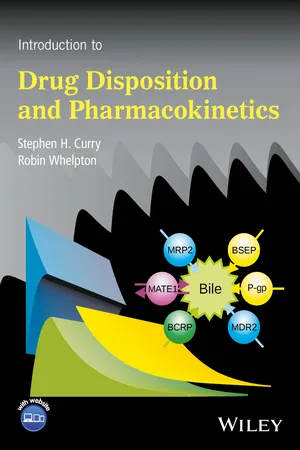
- English
- ePUB (mobile friendly)
- Available on iOS & Android
Introduction to Drug Disposition and Pharmacokinetics
About This Book
The application of knowledge of drug disposition, and skills in pharmacokinetics, are crucial to the development of new drugs and to a better understanding of how to achieve maximum benefit from existing ones. The book takes the reader from basic concepts to a point where those who wish to will be able to perform pharmacokinetic calculations and be ready to read more advanced texts and research papers.
The book will be of benefit to students of medicine, pharmacy, pharmacology, biomedical sciences and veterinary science, including those who have elected to study the topic in more detail, such as via electives and special study modules. It will be of benefit to those involved in drug discovery and development, pharmaceutical and medicinal chemists, as well as budding toxicologists and forensic scientists who require the appropriate knowledge to interpret their findings and as an introductory text for clinical pharmacologists. Early chapters describe the basic principles of the topic while the later ones illustrate the application of those principles to modern approaches to drug development and clinical use. Full colour illustrations facilitate the learning experience and supporting material for course leaders and students can be found on the Companion Web Site
"Another book on PK? Yes and there should be and it should be DD & PK. It is good, unique, and does fill a currently unmet need for those working in the xenobiotic arena. DD & PK is just like the perfect mystery novel—the one "you just can't put down." However, unlike a mystery novel which requires only one reading to find the answer, the reader of DD & PK will learn more than an answer to a single question. The reader will find many solutions to a wide variety of mysterious problems associated with the time course and actions of xenobiotics."
— International Journal of Toxicology, John A. Budny, PhD, President, PharmaCal, Ltd, 2018 "This book has many innovations that make a welcome addition to the bookshelves of a wide range of pharmaceutical scientists. The effective use of figures and tables to summarize and clarify a wide range of issues is to be commended, as are the learning objectives at the start of the chapter coupled with the summary at the end providing a succinct way in understanding the objectives of the chapter and together with links to a website provides accessibility for all from the neophyte pharmacokineticist to the consultant physician. A book all in the Pharma industry should be aware of. "
— Int. J. of Pharmacokinetics, Howard M. Hill, ResolvPharma, 2018 "Overall, Introduction to Drug Disposition and Pharmacokinetics offers its readership an in-depth view of classic pharmacokinetic concepts. This book would be an excellent choice for a pharmacokinetics elective or as an adjunctive text for an introductory course. This book reviews a wide array of clinically relevant topics and encourages the reader to apply the knowledge gained to all medi-cations. A robust and varied amount of online material is provided to enhance understanding and encourage discussion. It is likely that all readers, novice or experienced pharmacists, would find value in this textbook."
— Currents in Pharmacy Teaching and Learning, Milena McLaughlin, Midwestern University Chicago College of Pharmacy, 2018 "In summary, this is an excellent textbook for students new to the field of pharmaceutics and medical, pharmacy, and veterinary students, particularly those who envision a career in drug development research in either academia or industry."
— Veterinary Pathology Review, John K. Amory, University of Washington, 2018
Frequently asked questions
Information
1
Introduction: Basic Concepts
Learning objectives
- use the Henderson–Hasselbalch equation to calculate the ionization of weak acids and bases
- plot concentration–time data to determine first‐order and zero‐order rate constants
- explain the effect of ionization on the partitioning of weak electrolytes between buffers and octanol.
1.1 Introduction
- selection of the right drug for pharmaceutical development
- evaluation of drug delivery systems
- design of drug dosage regimens
- appropriate choice and use of drugs in the clinic.
Table of contents
- Cover
- Title Page
- Table of Contents
- Preface
- Companion Website Directions
- 1 Introduction
- 2 Drug Administration and Distribution
- 3 Drug Metabolism and Excretion
- 4 Single-compartment Pharmacokinetic Models
- 5 Multiple-compartment and Non-compartment Pharmacokinetic Models
- 6 Kinetics of Metabolism and Excretion
- 7 Clearance, Protein Binding and Physiological Modelling
- 8 Quantitative Pharmacological Relationships
- 9 Pharmacokinetics of Large Molecules
- 10 Pharmacogenetics and Pharmacogenomics
- 11 Additional Factors Affecting Plasma Concentrations
- 12 Effects of Age and Disease on Drug Disposition
- 13 Drug Interactions and Toxicity
- 14 Perspectives and Prospects
- Appendix 1: Mathematical Concepts and the Trapezoidal Method
- Appendix 2: Dye Models to Teach Pharmacokinetics
- Appendix 3: Curve Fitting
- Appendix 4: Pharmacokinetic Simulations
- Index
- End User License Agreement